

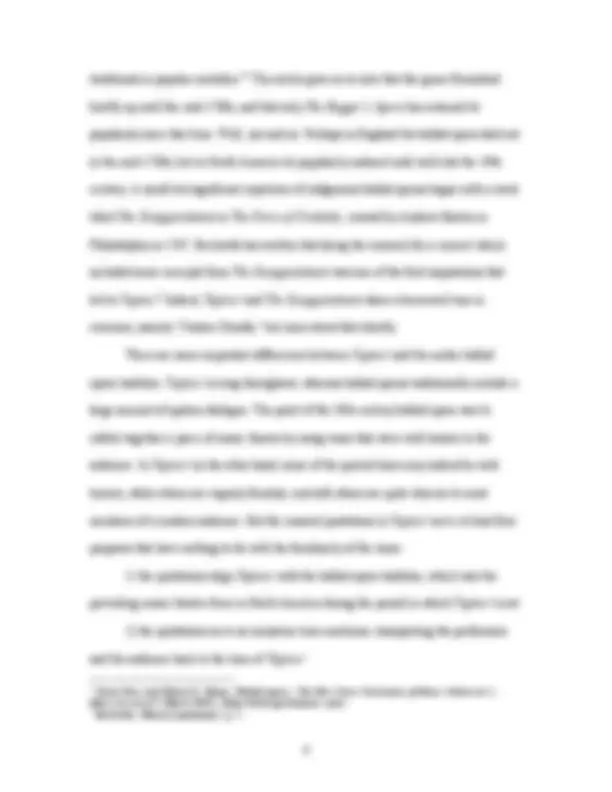
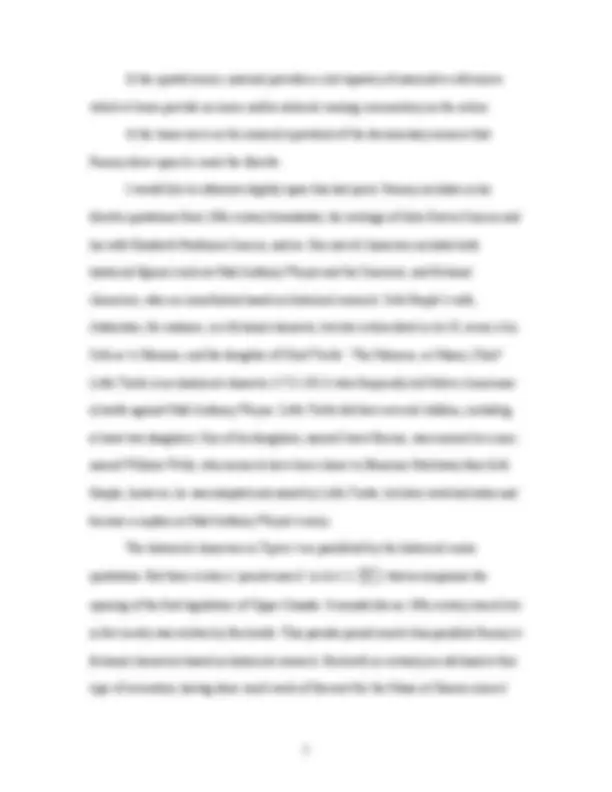
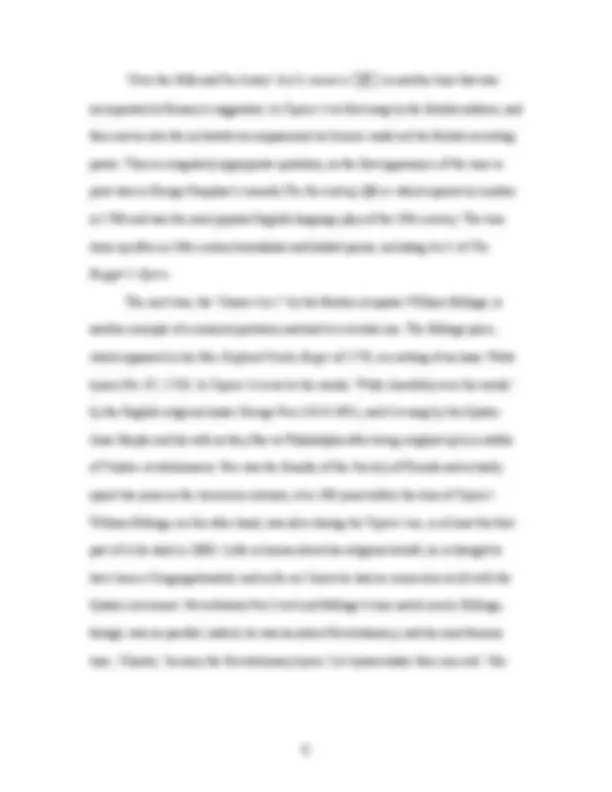
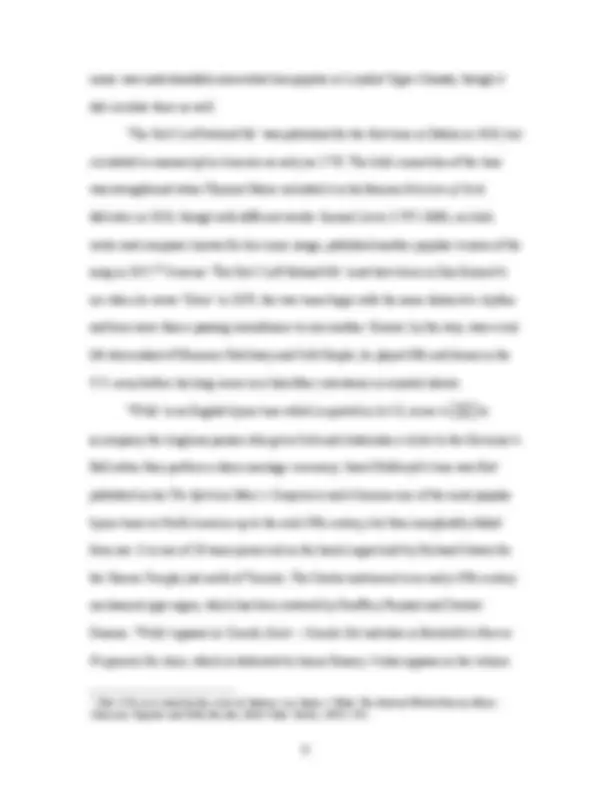
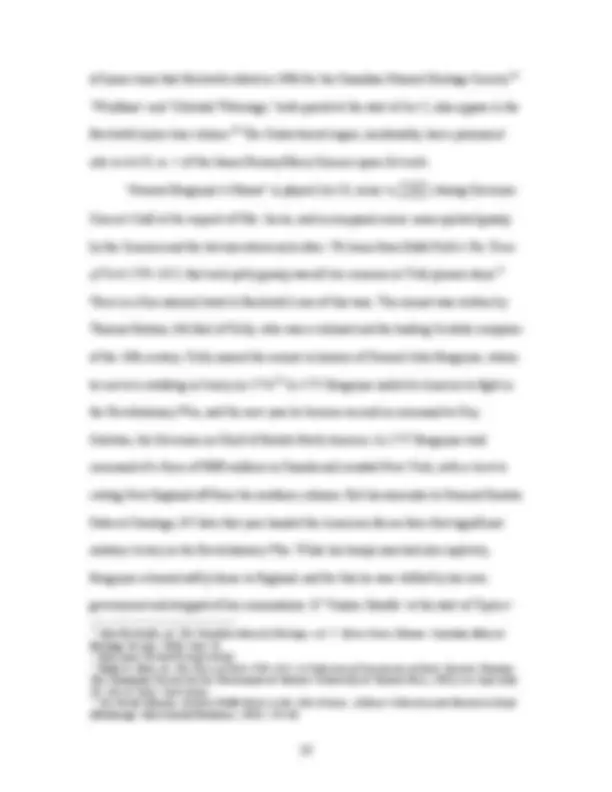


Study with the several resources on Docsity

Earn points by helping other students or get them with a premium plan


Prepare for your exams
Study with the several resources on Docsity

Earn points to download
Earn points by helping other students or get them with a premium plan
Community
Ask the community for help and clear up your study doubts
Discover the best universities in your country according to Docsity users
Free resources
Download our free guides on studying techniques, anxiety management strategies, and thesis advice from Docsity tutors
The Canadian musical piece 'Taptoo!' set during the American Revolution and War of 1812. the historical context, musical influences, and the use of musical quotations in the work. 'Taptoo!' is a work of music theatre and shares traits with the ballad opera genre, which was prevalent during the period. The document also highlights the influence of historical figures and sources on the composition.
Typology: Study notes
1 / 12

This page cannot be seen from the preview
Don't miss anything!







Chancellor Jackman Symposium on Taptoo! – Saturday, March 8, 2003 – Robin Elliott Taptoo! is set during the unstable period between the American Revolution and the War of 1812. As a music student growing up in Kingston I was well acquainted with some of the military and musical consequences of the European and North American wars of 1812. For many years I was a member of the Kingston Symphony, and took part in an annual summer pops concert at Fort Henry. The crowning moment of this event is a rendition of the 1812 Overture by Tchaikovsky, complete with a mobilization of the Fort Henry Guard and the firing of the Fort’s impressive cannons. As Margaret Atwood pointed out recently in The Globe and Mail ,^1 the 1812 Overture is a history lesson brought to life: the Russian cannons bomb the ‘Marseillaise’ into submission in the coda, and a rousing treatment of the imperial anthem ‘God Save the Tsar’ brings the work to a triumphant close. The performance at Fort Henry is an appropriate matching of music and location, for the fort was built in 1812 in response to fears that Kingston was a prime target in the recently declared war between Britain and the United States. The Fort Henry concert thus invites us to reflect upon the geopolitical connections between the two Wars of 1812. Tchaikovsky’s Russian cannons that bomb the French into submission become, in Kingston, the Canadian/British cannons that routed the U.S. forces in the War of 1812. The musician in me used to thrill to the spectacle of it all. But the historian in me is obliged to add that ‘God Save the Tsar’ was actually written 20 years after Napoleon’s retreat from Moscow and, come to think of it, that the Fort Henry cannons never fired a single shot at U.S. forces in warfare. All this is by way of a quick introduction to the fact
(^1) Margaret Atwood, ‘Bonaparte to Bush: you’ll be sorry,’ The Globe and Mail (1 March 2003): A17.
that music plus history may equal music history, but this is not always the same thing as the history that historians profess. Beethoven’s Wellington’s Victory was another Fort Henry pops concert favorite. It was written in 1813 to commemorate the victory of the Duke of Wellington over Napoleon at the Battle of Vitoria in Spain that year. Wellington’s Victory is dedicated to George Augustus Frederick, the Prince Regent of Britain, who was ruling in place of his father, mad King George III, who is tarred and feathered in effigy at the start of Taptoo!. At the beginning of Wellington’s Victory the opposing armies are introduced by means of drum and trumpet signals and borrowed themes: Thomas Arne’s ‘Rule Britannia’ for the English and the folksong ‘Malbrook s’en va-t-en guerre’ for the French. Drum and trumpet signals and ‘Rule Britannia’ feature prominently in Taptoo! as is seen in the appendix, the former in Act I, 50 and 105 and elsewhere, and ‘Rule Britannia’ in Act
2, 126 for Simcoe’s proclamation of the founding of Toronto (or rather York). The 1812 Overture and Wellington’s Victory are grandiose if rather late blooming additions to a genre of descriptive programmatic works known as ‘battle music.’ Taptoo! shares several traits in common with such works, including the use of musical quotations ranging from folksongs to religious music, the programmatic depiction of military engagements, and the musical evocation of national allegiances. Battle music pieces began to be written in the 16th-century, but a marked resurgence of interest in the genre occurred between the years 1780 and 1810, the very time period in which Taptoo! is set. The Battle of Prague by Francis Kotzwara was one of the most popular pieces in this genre; it was published in Dublin ca. 1788 and quickly gained enormous popularity on both sides of the Atlantic. The New Grove states that Kotzwara was ‘accidentally
traditional or popular melodies.’^4 The article goes on to note that the genre flourished briefly up until the mid-1730s, and that only The Beggar’s Opera has retained its popularity since that time. Well, yes and no. Perhaps in England the ballad opera died out in the mid-1730s, but in North America its popularity endured until well into the 19th century. A small but significant repertoire of indigenous ballad operas began with a work titled The Disappointment or The Force of Credulity , created by Andrew Barton in Philadelphia in 1767. Beckwith has written that doing the research for a concert which included some excerpts from The Disappointment was one of the first inspirations that led to Taptoo!^5 Indeed, Taptoo! and The Disappointment share a borrowed tune in common, namely ‘Yankee Doodle,’ but more about that shortly. There are some important differences between Taptoo! and the earlier ballad opera tradition. Taptoo! is sung throughout, whereas ballad operas traditionally include a large amount of spoken dialogue. The point of the 18th-century ballad opera was to cobble together a piece of music theatre by using tunes that were well known to the audience. In Taptoo! on the other hand, some of the quoted tunes may indeed be well known, while others are vaguely familiar, and still others are quite obscure to most members of a modern audience. But the musical quotations in Taptoo! serve at least four purposes that have nothing to do with the familiarity of the tunes.
music genre which commemorates one of George Washington’s most famous victories in the Revolutionary War (on Christmas Day, 1776).^10 ‘Yankee Doodle’ was the subject of a famous investigation by Oscar Sonneck, the founding father of American music studies.^11 It was Sonneck who virtually invented the scholarly study of 18th-century American music, and so in a sense he is the philosophical grandfather of Taptoo! In his 80-page discussion of ‘Yankee Doodle,’ Sonneck summarizes no less than 16 theories about the creation of the tune, only to discredit them all and conclude that its origins remain ‘as mysterious as ever.’ A persistent theme in Sonneck’s account, though, is that ‘Yankee Doodle’ was sung by the British to mock the Americans, who responded by adopting it as a patriotic tune in the Revolutionary period. Perhaps Reaney and Beckwith, then, have brought the tune full circle – but that is for the listener to judge. ‘Mad Anthony Wayne,’ the third tune on the list, is an example of how a musical quotation can reinforce a textual one, for the tune appears in the orchestra to accompany Wayne as he sings the text of an actual recruiting poster of the era. The original tune for ‘Mad Anthony Wayne,’ which dates from Wayne’s time and was a setting of words by one of his officers, is lost unfortunately, and has been replaced by the one that Beckwith quotes. This tune was composed by Albert G. Emerick for his compilation Songs for the People in 1852. This is the only time that Beckwith makes use of what might be called the Tchaikovsky dispensation, namely the use of an anachronistic tune simply because it makes good music historical sense, despite its lack of historical authenticity.
(^10) A modern edition of the work is available: James Hewitt, The Battle of Trenton: A Favorite Historical Military Sonata Dedicated to George Washington (^11) Oscar George Theodore Sonneck, Report on “The Star-Spangled Banner” “Hail Columbia” “America” , ed. Maurice Hinson (Miami: Belwin Mills, 1988). “Yankee Doodle” Washington: Government Printing Office, 1909.
‘Over the Hills and Far Away’ (Act I, scene ii / 39 ) is another tune that was incorporated at Reaney’s suggestion. In Taptoo! it is first sung by the British soldiers, and then moves into the orchestral accompaniment as Simcoe reads out the British recruiting poster. This is a singularly appropriate quotation, as the first appearance of the tune in print was in George Farquhar’s comedy The Recruiting Officer which opened in London in 1706 and was the most popular English-language play of the 18th century. The tune turns up often in 18th-century broadsides and ballad operas, including Act 1 of The Beggar’s Opera. The next tune, the ‘Canon 4 in 1’ by the Boston composer William Billings, is another example of a musical quotation matched to a textual one. The Billings piece, which appeared in his New England Psalm-Singer of 1770, is a setting of an Isaac Watts hymn (No. 87, 1710). In Taptoo! it is set to the words, ‘Walk cheerfully over the world,’ by the English religious leader George Fox (1624-1691), and it is sung by the Quaker Jesse Harple and his wife as they flee to Philadelphia after being roughed up by a rabble of Yankee revolutionaries. Fox was the founder of the Society of Friends and actually spent two years in the American colonies, over 100 years before the time of Taptoo!. William Billings, on the other hand, was alive during the Taptoo! era, or at least the first part of it (he died in 1800). Little is known about his religious beliefs; he is thought to have been a Congregationalist, and as far as I know he had no connection at all with the Quaker movement. Nevertheless Fox’s text and Billings’s tune match nicely. Billings, though, was no pacifist; indeed, he was an ardent Revolutionary, and his most famous tune, ‘Chester,’ became the Revolutionary hymn ‘Let tyrants shake their iron rod.’ His
of hymn tunes that Beckwith edited in 1986 for the Canadian Musical Heritage Society.^13 ‘Windham’ and ‘Celestial Waterings,’ both quoted at the start of Act 2, also appear in the Beckwith hymn tune volume.^14 The Coates barrel organ, incidentally, has a prominent role in Act II, sc. v of the James Reaney/Harry Somers opera Serinette. ‘General Burgoyne’s Minuet’ is played (Act II, scene vi, 110 ) during Governor Simcoe’s ball at the request of Mrs. Jarvis, and accompanies some mean spirited gossip by the Simcoes and the Jarvises about each other. We learn from Edith Firth’s The Town of York 1793-1815 , that such petty gossip was all too common in York pioneer days.^15 There is a fine satirical twist to Beckwith’s use of this tune. The minuet was written by Thomas Erskine, 6th Earl of Kelly, who was a violinist and the leading Scottish composer of the 18th century. Kelly named the minuet in honour of General John Burgoyne, whom he met at a wedding in Surrey in 1774.^16 In 1775 Burgoyne sailed to America to fight in the Revolutionary War, and the next year he became second-in-command to Guy Carleton, the Governor-in-Chief of British North America. In 1777 Burgoyne took command of a force of 9000 soldiers in Canada and invaded New York, with a view to cutting New England off from the southern colonies. But his surrender to General Horatio Gates at Saratoga, NY later that year handed the American forces their first significant military victory in the Revolutionary War. While his troops marched into captivity, Burgoyne returned safely home to England, and for this he was vilified by his own government and stripped of his commissions. If ‘Yankee Doodle’ at the start of Taptoo! (^13) John Beckwith, ed. The Canadian Musical Heritage, vol. 5: Hymn Tunes (Ottawa: Canadian Musical Heritage Society, 1986): tune 16. (^14) Ibid, tunes 98 and 96 respectively. (^15) Edith G. Firth, ed. The Town of York 1793-1815: A Collection of Documents of Early Toronto (Toronto: The Champlain Society for the Government of Ontario / University of Toronto Press, 1962); see especially‘H. Life in York,’ lxxv-lxxxv. (^16) See David Johnson, Scottish Fiddle Music in the 18th Century: A Music Collection and Historical Study (Edinburgh: John Donald Publishers, 1984): 159-60.
can be read as an ironic thumbing of the nose at the American revolutionaries, then ‘General Burgoyne’s Minuet’ towards the close of it is no less a satirical jab at the foibles of the upper levels of the social hierarchy in Upper Canada. I have suggested the battle piece and the ballad opera as possible frameworks for considering Taptoo! and more particularly the use of musical quotations in that work. But the opera can also be seen in the context of the larger creative output of Beckwith, and also of Reaney. Taptoo! is the prequel to the James Reaney and Harry Somers opera Serinette , which was premiered at the Sharon Temple in 1990 and was recorded in
2001.^17 Whereas Taptoo! ends on the eve of the War of 1812, Serinette begins just as the troops are returning to Fort York at the end of that war. Both operas are partly set in York and both include a mix of historical and fictional characters and incidents. Mr. and Mrs. Jarvis, who make a cameo appearance in Taptoo! at the Governor’s Ball, become two of the major characters in Serinette. Similarly, the conflict between pacifist Quakers and belligerent Americans which opens Taptoo! becomes a major theme in Serinette , though in the latter work it is played out as a contrast between The Children of Peace, a breakaway sect of the Quaker movement, and the hard nosed residents of York. Beckwith and Reaney share many artistic techniques and aesthetic principles in common. Catherine Ross, in writing of Reaney’s work as a writer, notes that ‘[he] has combined archival research, poetry, elements of romance and melodrama, mime and myth to tell the central stories and legends of Ontario’.^18 A similar blend of scholarship and creativity informs John Beckwith’s work. You never have to travel far in Canadian music scholarship – or indeed in Canada – before you run into the work of Beckwith. A (^1718) Centrediscs CMCCD 76/7701 (a 2-CD set), conducted by Victor Feldbrill. (accessed 1 March 2003), http://www.canadianencyclopedia.ca.Catherine Ross, ‘James Crerar Reaney,’^ The Canadian Encyclopedia Online , ed. James H. Marsh